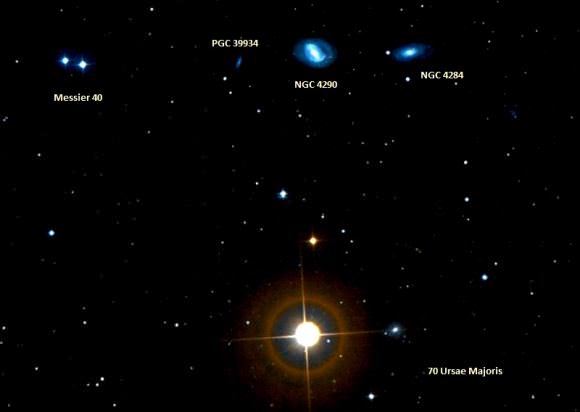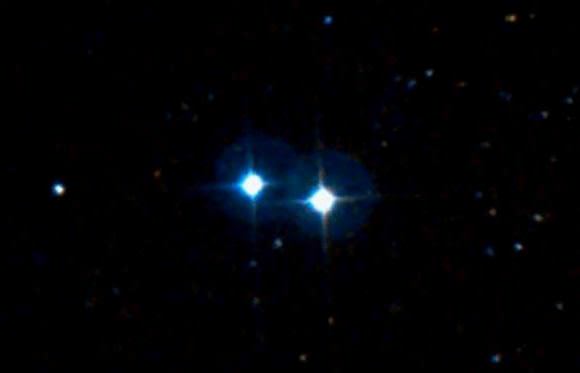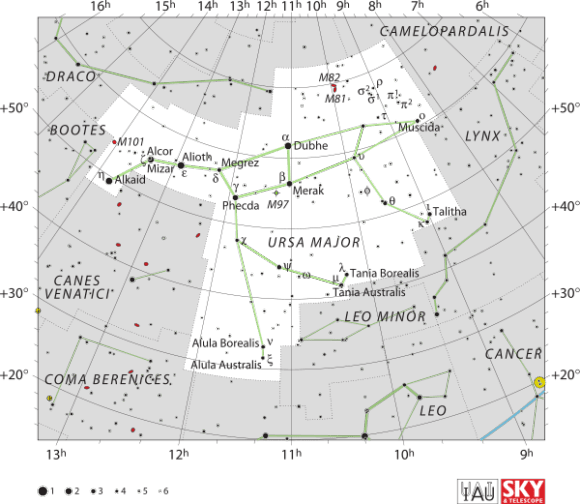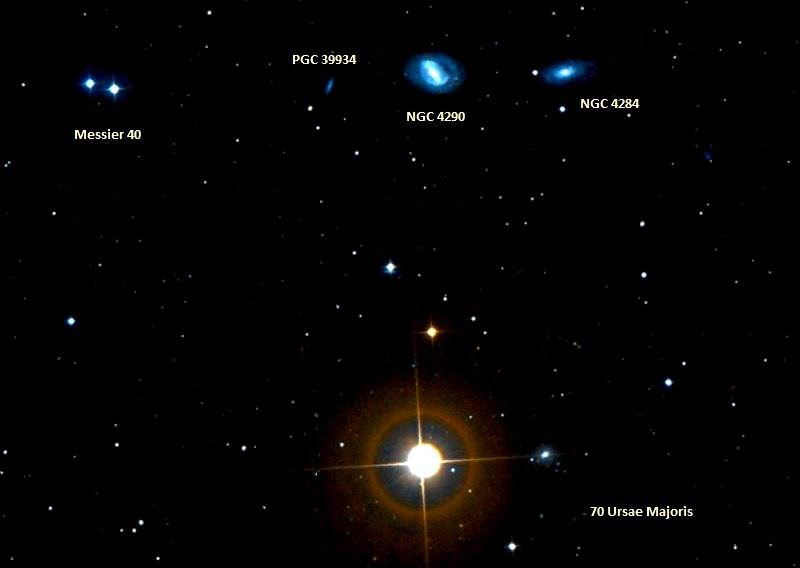During the 18th century, famed French astronomer Charles Messier noted the presence of several “nebulous objects” in the night sky. Having originally mistaken them for comets, he began compiling a list of them so that others would not make the same mistake he did. In time, this list (known as the Messier Catalog) would come to include 100 of the most fabulous objects in the night sky.
One of these objects is Messier 40, this double star is now known to be an optical double star (i.e. two independent stars at different distances that appear aligned based on our perspective). It is also included in the Winnecke Catalogue of Double Stars as number 4, and is located in the constellation of Ursa Major (aka. the Big Dipper).
Description:
At roughly 500 light years away from us, no one is quite sure if this pair of stars is truly a binary system or an optical double star. According to Richard Nugent’s 2002 data, “The observed relative proper motion, as measured in separation and position angle, is consistent with a straight, independent motion of the two stars, one crossing between us and the other.”

The two stars are nearly the same brightness as each other, with the primary star being magnitude 9 and the secondary being magnitude 9.3 and they are separated by about 49 arc seconds – a wide gap. At one time, the angular separation of the pair was measured at 49.2″, but has gradually changed to about 52.8″ in more recent years.
History of Observation:
Messier 40 was discovered by Charles Messier in 1764 while he was searching for a nebula that had been reported in the area by Johann Hevelius. As he wrote at the time:
“The same night on October 24-25, [1764], I searched for the nebula above the tail of the Great Bear [Ursa Major], which is indicated in the book Figure of the Stars, second edition: it should have, in 1660, the right ascension 183d 32′ 41″, and the northern declination 60d 20′ 33″. I have found, by means of this position, two stars very near to each other and of equal brightness, about the 9th magnitude, placed at the beginning of the tail of Ursa Major: one has difficulty to distinguish them with an ordinary refractor of 6 feet. Here are their position: right ascension, 182 deg 45′ 30″, and 59 deg 23′ 50″ northern declination. There is reason to presume that Hevelius mistook these two stars for a nebula.”
History often credits Messier for being a little bit crazy for cataloging a double star, but upon having read Messier’s report, I feel like he was an astronomer doing his job. If Hevelius reported a nebula here – then he was bound to look and write down what he saw. He didn’t just stumble on a double star and catalog it for no reason!

Later astronomers would also search for M40 and report a double star, and it was cataloged by such as by Friedrich August Theodor Winnecke at Pulkovo Observatory in 1863 as WNC 4. However, to give the good Hevelius credit, John Mallas reports, “the Hevelius object is the 5th-magnitude star 74 Ursae Majoris, more than one degree away, as reference to his star catalogue will show.”
In 1991, the separation between the stars was measured at 52.8 arcseconds, which represented an increase since 1966, when it was measured at 51.7. In 2001 and 2002, studies conducted by Brian Skiff and Richard L. Nugent suggested that the stars comprising the double star (HD 238107 and HD 238108) were in fact an optical double star, rather than a double star system.
In 2016, by using parallax measurements from the Gaia satellite, this theory was proven for the first time. Distance estimates were also produced, indicating that the two components are 350±30 and 140±5 parsecs (~1141±98 and 456±16 light years).
Locating Messier 40:
Finding Messier 40 isn’t very difficult for fairly large binoculars and small telescopes – but you need to remember that it’s a double star. First locate the easily recognized constellation of Ursa Major and focus on the ‘Big Dipper’ and look for the two stars that form the edge that connect to the handle – Gamma and Delta.

Aim your telescope’s finderscope at Delta – the point where the ‘handle’ would connect. In the finder, you will see a fainter star to the northeast. Hop there. Now, using a low power eyepiece, scan slightly further northeast and you will locate M40. Once located, you may go to higher magnification to more closely examine this Messier catalog curiosity.
While this pair of stars will show easily in binoculars, you must remember that binoculars give such a wide field that it will be difficult to distinguish them from surrounding stars. However, this is a great object for light-polluted skies and moonlit nights!
Enjoy the controversy… and this pair! And here are the quick facts on M40 to help you get started:
Object Name: Messier 40
Alternative Designations: M40, WNC 4
Object Type: Double Star
Constellation: Ursa Major
Right Ascension: 12 : 22.4 (h:m)
Declination: +58 : 05 (deg:m)
Distance: 0.51 (kly)
Visual Brightness: 8.4 (mag)
Apparent Dimension: 0.8 (arc min)
We have written many interesting articles about Messier Objects here at Universe Today. Here’s Tammy Plotner’s Introduction to the Messier Objects, , M1 – The Crab Nebula, M8 – The Lagoon Nebula, and David Dickison’s articles on the 2013 and 2014 Messier Marathons.
Be to sure to check out our complete Messier Catalog. And for more information, check out the SEDS Messier Database.
Sources:

